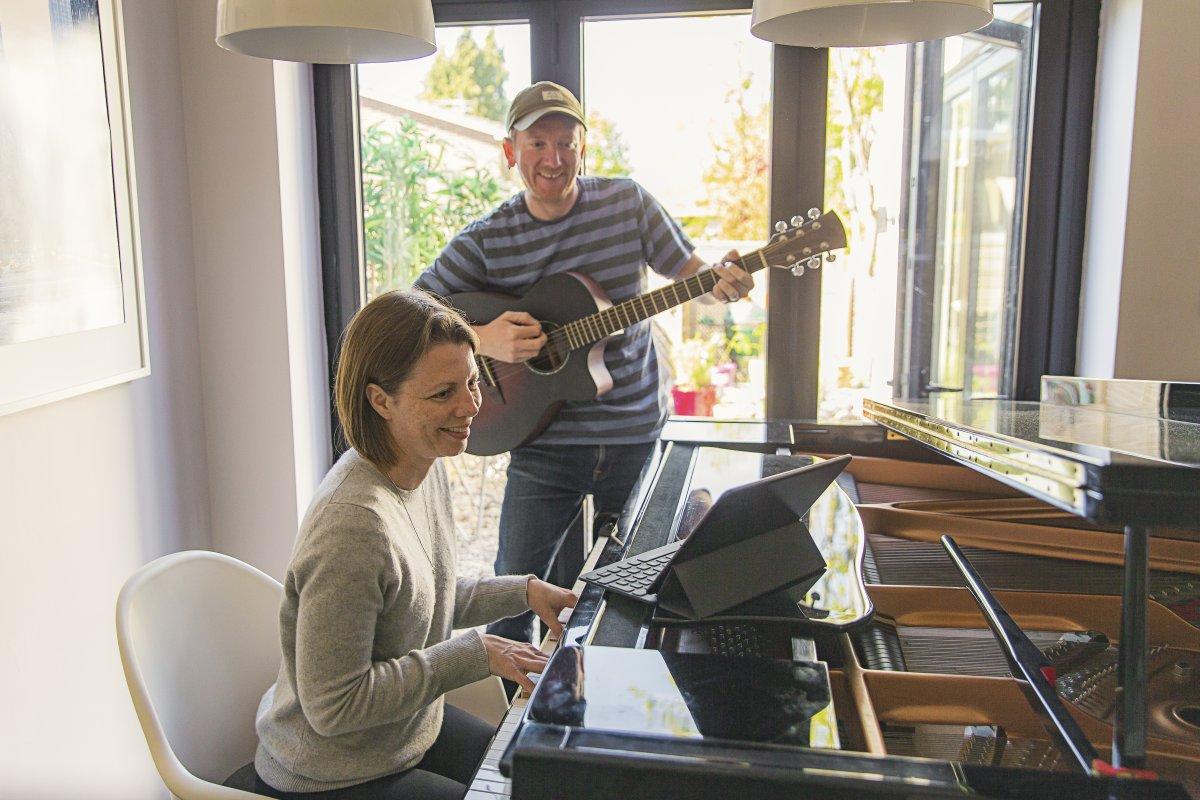Have you ever been curious about how to convert guitar chords to piano chords? We can’t let guitarists have all the fun playing classics like “Stairway to Heaven” and “Hotel California!” Pianists deserve a go on these famous tunes, too.
Just because a song is written in tabs doesn’t mean that piano players can’t read it as well. When it comes to the guitar vs. piano, some chords are transferable, meaning if you know the chords on both instruments, you can play your favorite songs on either one. Pretty rad, right?
If you’re looking to convert guitar chords to piano chords so that you can play some of your favorite guitar numbers on the piano, then you’ve come to the right place. In this article, we’ll show you how to properly translate guitar chords to piano using tabs.
Convert Guitar Chords to Piano Chords
First, let’s establish a basic understanding of the guitar. The notes of the open strings from thickest to thinnest are E, A, D, G, B, and E. Also, each fret on the guitar is a half step.
This means that you can find any note by starting from the open string that the note is played on and counting up in half steps, one fret at a time, until you arrive at the desired note.
Once you’re familiar with the notes on the guitar, you can move on to the notes on the piano.
Are Guitar Chords and Piano Chords the Same?
Before we dive in any further, let’s get one thing straight: Are guitar chords and piano chords the same? To be honest, the answer can be a little confusing.
You see, you can play the same notes and chords on the guitar and piano, but you must play them in different positions to achieve similar sounds. The real difference comes down to the sound they make, as a guitar chord will have a slightly different tone than the same chord played on the piano.
To demonstrate the difference, let’s look at the G Major chord. How do you convert the G chord guitar to piano? Well, on the guitar, you produce that chord by playing these notes: G B D G B G. But to play the same chord on the piano, you only play these three notes: G B D.
So yes, you can convert guitar chords to the piano, but will they sound exactly the same? No, they will sound similar, but not exactly the same. Will you use the same notes to produce the same chord? No, not necessarily.
Understanding Guitar Tabs
In this tutorial, we’ll be using tabs to convert the guitar chords to piano chords. The good news is that you don’t need to know how to read sheet music in order to read guitar tabs. What you need to know about tabs is that there are six lines that represent the six guitar strings. The bottom line represents the thickest string, while the top represents the thinnest.
The numbers you’ll see on each line indicate the number of the fret that is played on that string. As far as reading rhythms, tabs usually only approximate rhythms. But as you read the fret numbers from left to right, more or less spaces between numbers indicate note values and rests.
So, more space between two numbers means that you’ll either hold the note or rest until the next one is played. If numbers are stacked on top of each other vertically, that means those notes are played at the same time.
Practice Converting Guitar Chords to Piano
To really get a grasp on transferring guitar chords to the piano, you’ll want to brush up on your music theory. When you have a better understanding of scales and the musical structure of chords, you’ll have an easier time mapping out the chords on each perspective instrument.
In a nutshell, the basic idea for translating guitar chords to piano is a method of counting up in half steps from an open string.
After getting some practice with this method, you can effectively steal all the guitarists’ favorite songs!
Let’s practice by sinking our teeth into one of the most wonderfully cliché, guitar-based songs ever made – “Stairway to Heaven” by Led Zeppelin. Take a look at the video below that provides the tabs.
Now it’s time to figure out the right piano notes, and from there, the appropriate piano chords to play!
We’ll just focus on the first measure for now. To find the first note, we look at which string it’s played on. The number 7 is on the third line from the bottom, which indicates the D string.
Since the fret number is 7, we’re going to count up 7 half steps from the open D string. Feel free to use your piano to help you do this. When we count up we get these notes: D, D#, E, F, F#, G, G#, A.
So, A is the first note. Next, let’s look at the second note. It’s played on the third thinnest string, which is a G. Since the number is 5, we count up 5 half steps from the open G string, giving us these notes: G, G#, A, A#, B, C.
So, our second note is C. Keep using this process to find the next notes.
When we get to beat 3 of this measure, there is a 7 and a 6 stacked on top of each other. This means that both notes are played at the same time. The 7 is on the thinnest string, E, while the 6 is on the third from the bottom string – D.
Starting with the thinnest string, E, let’s count up 7 half steps: E, F, F#, G, G#, A, A#, B. Now, count up 6 half steps from D: D, D#, E, F, F#, G, G#. So you’ll play B and G# at the same time.
Sign up for Private Music Lessons Today
Understanding how to transfer guitar tabs to the piano can open up a whole new world of music for you. Not only will you be able to play some of your favorite guitar solos on the piano and vice versa, but you’ll also challenge yourself and take your musical skills to new heights.
With that said, if you’re still trying to make sense of converting notes and songs from guitar to piano, turn to private music lessons for additional guidance. At TakeLessons, you can study one-on-one with a certified music teacher who will help you wrap your head around all of these musical concepts. With some patience and plenty of practice, you’ll be jamming out on the guitar and the piano in no time!
 Post Author: Andy W. teaches guitar, piano and more in Greeley, CO. He specializes in jazz, and has played guitar for more than 12 years. Learn more about Andy here!
Post Author: Andy W. teaches guitar, piano and more in Greeley, CO. He specializes in jazz, and has played guitar for more than 12 years. Learn more about Andy here!
Photo by angelocesare
Suzy S.
